Modern servers on Intel Xeon E5-2600 on the example of ETegro Hyperion RS230 G4
Hello, hello. Today we would like to tell you about the latest ETegro Hyperion RS servers built on the new Intel Xeon E5-2600 processors, and using their example to show and tell you what you can “squeeze” out of the modern server platform, if you approach it with all the diligence. Perhaps this topic may not seem very interesting to you, but still: how often do you look in modern servers and how well do you know their capabilities? Maybe we should refresh our memory? We chose this line of servers for a reason. Firstly, it is the servers on this latest platform that are now extremely popular among the corporate sector, and secondly, we are somewhat proud that we presented them to the Russian market before others. And we will talk about the model ETegro Hyperion RS230 G4 - dual-processor server in the performance of 2U.  Before we go inside the server, let us briefly introduce ourselves. We, the company ETegro Technologies, is a Russian company that develops and manufactures a wide variety of computing equipment, including servers, data storage systems, cluster solutions, workstations and graphics stations, and more ... For more information, visit our website: http: // www. etegro.com. We hope that our blog will become not just another “dull corporate blog of the company”, but a full-fledged interesting source of information. Well, now to the business. Perhaps, everyone who is interested in the server market has already managed to look at the new Intel platform. However, ETegro produces proprietary platforms. Therefore, we strive to share with you our original approach to the design of new generation servers. It is already our fourth, which is labeled as G4 at the end of the name.
Before we go inside the server, let us briefly introduce ourselves. We, the company ETegro Technologies, is a Russian company that develops and manufactures a wide variety of computing equipment, including servers, data storage systems, cluster solutions, workstations and graphics stations, and more ... For more information, visit our website: http: // www. etegro.com. We hope that our blog will become not just another “dull corporate blog of the company”, but a full-fledged interesting source of information. Well, now to the business. Perhaps, everyone who is interested in the server market has already managed to look at the new Intel platform. However, ETegro produces proprietary platforms. Therefore, we strive to share with you our original approach to the design of new generation servers. It is already our fourth, which is labeled as G4 at the end of the name. 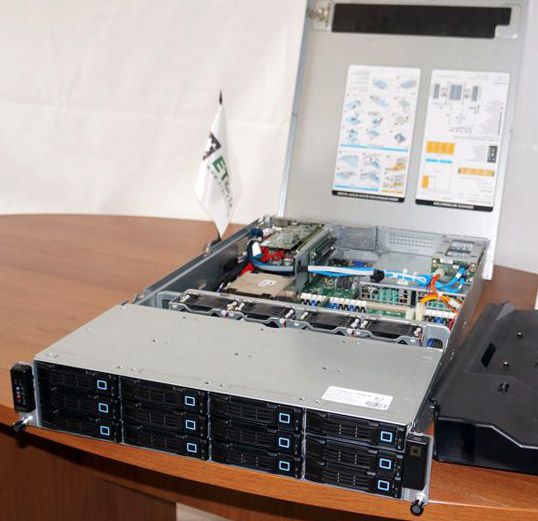
Let's take a look inside this 2U-handsome (we have single-unit models in this series, but they are almost the same in design, and we'll talk about them in one of the following posts, when ... well, we still have topics to talk about).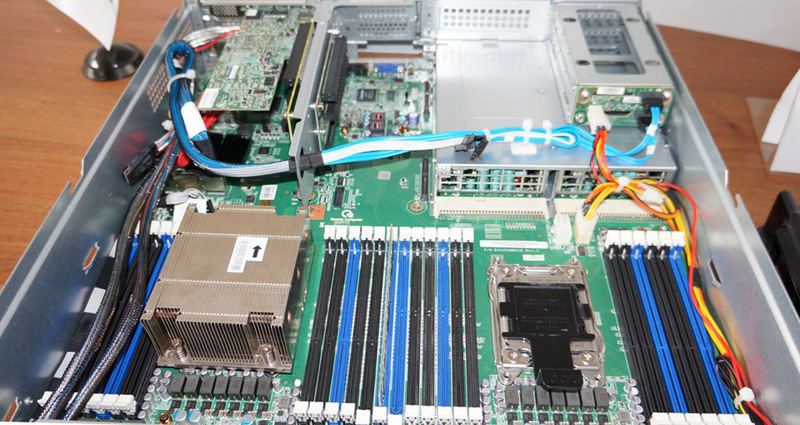 The focus is on the motherboard of its own design, with two processor sockets located on it. The Intel Xeon E5-2600 series processors installed in them provide significant performance gains compared with the previous generation, reaching up to 80%, and in the case of floating point calculations, it is two-fold. This is largely due to the increased desire of the traditionally very conservative corporate sector to switch to a new platform - it saves space with a noticeable gain in performance.
The focus is on the motherboard of its own design, with two processor sockets located on it. The Intel Xeon E5-2600 series processors installed in them provide significant performance gains compared with the previous generation, reaching up to 80%, and in the case of floating point calculations, it is two-fold. This is largely due to the increased desire of the traditionally very conservative corporate sector to switch to a new platform - it saves space with a noticeable gain in performance. 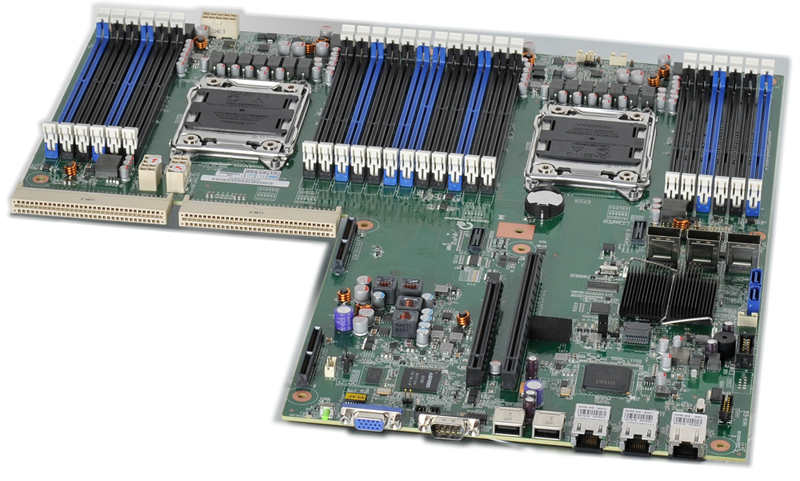 The new design of the motherboard and the capabilities of the Intel Xeon E5-2600 processors allowed us to separate and install 24 DDR3-1600 memory slots on it. Memory does not happen much, right? So if finances allow, you can install up to 768 GB of memory in 4-channel mode in just one 2U server. A separate pleasant moment is the use of LRDIMM modules - their energy consumption is very small, which is extremely pleasant for both electricity bills and cooling needs.
The new design of the motherboard and the capabilities of the Intel Xeon E5-2600 processors allowed us to separate and install 24 DDR3-1600 memory slots on it. Memory does not happen much, right? So if finances allow, you can install up to 768 GB of memory in 4-channel mode in just one 2U server. A separate pleasant moment is the use of LRDIMM modules - their energy consumption is very small, which is extremely pleasant for both electricity bills and cooling needs. 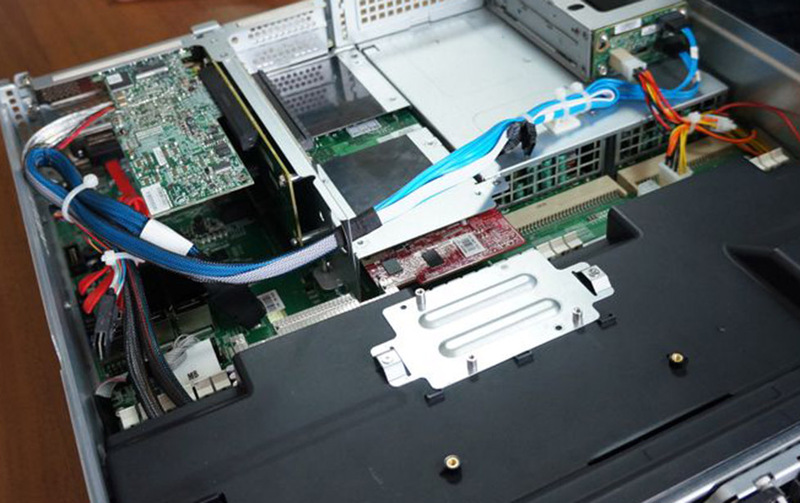 Next come ... right, expansion slots. And here we again have something to interest the user. The fact is, we use daughter boards of our own production (there are already two slots for them), which allowed us to make them as compact as possible, and to rationalize the remaining space. As a result, with the help (no, not a hammer and some kind of mother there) of the riser (this is a special board that stands upright and allows you to put expansion cards parallel to the motherboard), we have five PCI-Express 3.0 slots. By the way, the metal platform on the plastic duct right in front of us is not our abstract whim, but a place to accommodate the battery of the RAID controller.
Next come ... right, expansion slots. And here we again have something to interest the user. The fact is, we use daughter boards of our own production (there are already two slots for them), which allowed us to make them as compact as possible, and to rationalize the remaining space. As a result, with the help (no, not a hammer and some kind of mother there) of the riser (this is a special board that stands upright and allows you to put expansion cards parallel to the motherboard), we have five PCI-Express 3.0 slots. By the way, the metal platform on the plastic duct right in front of us is not our abstract whim, but a place to accommodate the battery of the RAID controller. 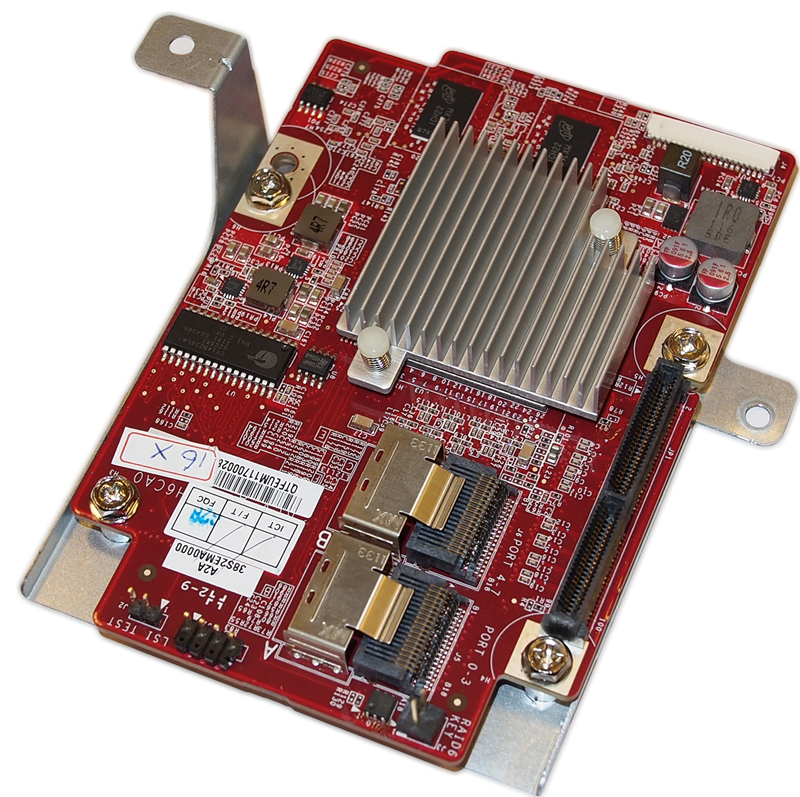
 As for the daughter boards, the one with the red textolite is the SAS RAID controller or HSI adapter of the LSI company (by the way, it is almost two times smaller than the analogous "proprietary" controller), and the second (green) bears on itself two 10G SFP + Ethernet port (there are two more ports on the motherboard itself, and they can be both Gigabit and 10G, if your network is already ready for such speeds). However, if you don’t need these daughterboards, but desperately want one more kind of your own controller, then you can put another riser into two slots instead of them, and you can install the additional sixth controller in it.
As for the daughter boards, the one with the red textolite is the SAS RAID controller or HSI adapter of the LSI company (by the way, it is almost two times smaller than the analogous "proprietary" controller), and the second (green) bears on itself two 10G SFP + Ethernet port (there are two more ports on the motherboard itself, and they can be both Gigabit and 10G, if your network is already ready for such speeds). However, if you don’t need these daughterboards, but desperately want one more kind of your own controller, then you can put another riser into two slots instead of them, and you can install the additional sixth controller in it. 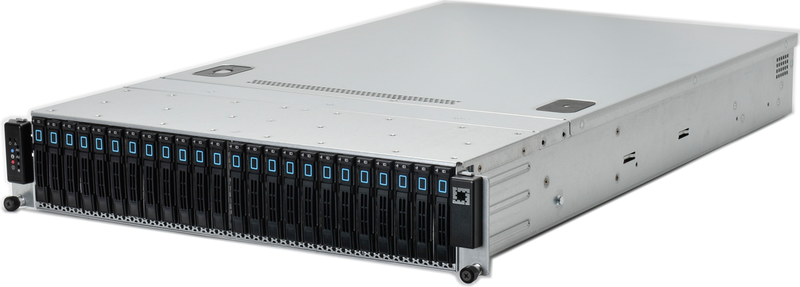 Since we touched the word RAID - it's time to talk about the disk subsystem. Here, modern 2U systems have already formed a certain standard. We release 2 versions of the case: one is designed for 12 seats with hot-swapping for 3.5-inch disks - that’s what the title photo gives to the article. The second modification presented in the photo takes up to 24 2.5-inch drives due to the vertical installation of disks. In the first version, we decided to leave the user with maximum freedom, so we use special 3.5-inch landing baskets, which allow replacing “large »Drives on smaller brethren, which makes it easy to assemble mixed combinations (with modern SSD distribution, this is very practical) - what this option looks like can be seen in the photo below.
Since we touched the word RAID - it's time to talk about the disk subsystem. Here, modern 2U systems have already formed a certain standard. We release 2 versions of the case: one is designed for 12 seats with hot-swapping for 3.5-inch disks - that’s what the title photo gives to the article. The second modification presented in the photo takes up to 24 2.5-inch drives due to the vertical installation of disks. In the first version, we decided to leave the user with maximum freedom, so we use special 3.5-inch landing baskets, which allow replacing “large »Drives on smaller brethren, which makes it easy to assemble mixed combinations (with modern SSD distribution, this is very practical) - what this option looks like can be seen in the photo below. 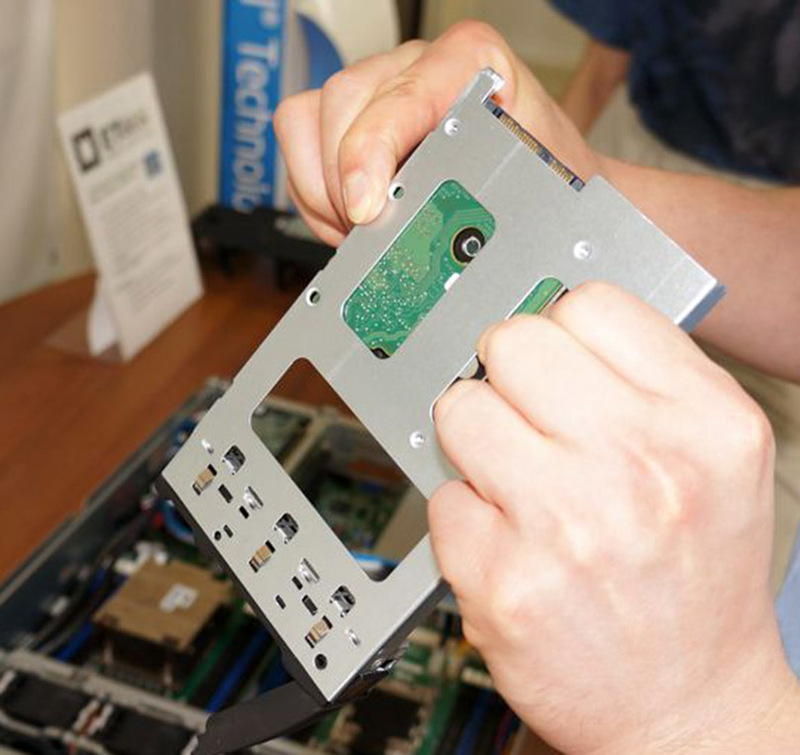 And yet we wanted to stand out from the background of traditional server "designers", so the SAS-expander used by us can work along two access paths at once (of course, support from the controller is required), which means the disk basket has twice the SAS 6G throughput. What to do if “stuffing” the system with SSD'shkami, then this is not so much.
And yet we wanted to stand out from the background of traditional server "designers", so the SAS-expander used by us can work along two access paths at once (of course, support from the controller is required), which means the disk basket has twice the SAS 6G throughput. What to do if “stuffing” the system with SSD'shkami, then this is not so much. 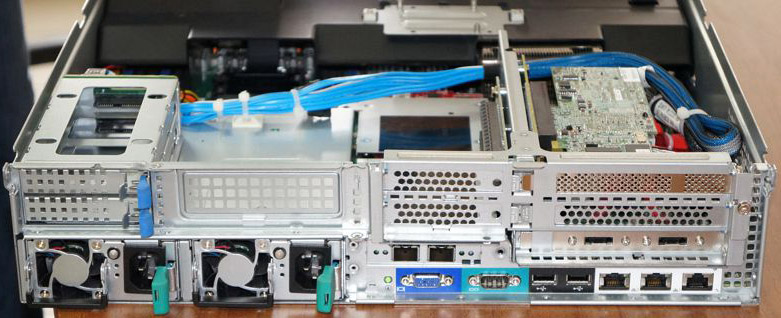 We also provided for two additional seats for 2.5-inch disks near the power supplies - yes, there are two small compartments in the upper left. If you want to use the system to the maximum, then it is possible that they will come in very handy: after all, you can put a disk with the OS there, and fill the basket with one large array. Well, or send there a caching SSD for a RAID controller, if you want to use a similar option.
We also provided for two additional seats for 2.5-inch disks near the power supplies - yes, there are two small compartments in the upper left. If you want to use the system to the maximum, then it is possible that they will come in very handy: after all, you can put a disk with the OS there, and fill the basket with one large array. Well, or send there a caching SSD for a RAID controller, if you want to use a similar option. 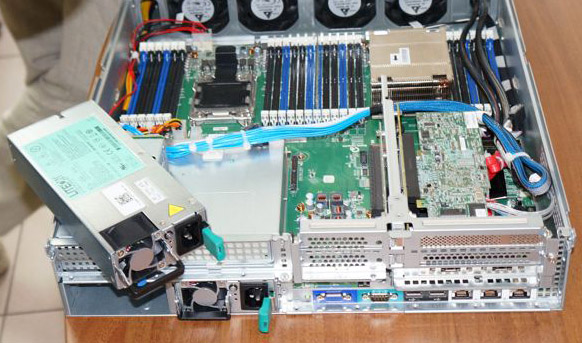
 Well, we smoothly got to power. And it is required decently, because it is necessary to proceed from the fact that the maximum configuration of possible components will be established. 2 processors, 24 memory modules, 14 disks, 7 expansion cards ... In general, hello 1100 watts. More precisely, two times 1100 W each, since a modern mid-level server is unthinkable without power redundancy. To accommodate them, we had to go to the trick, not only military, but engineering: at the output of power supplies, we remove only 12V for a couple of dozen conductors that go directly to the motherboard. All other voltages are created on the board itself. This approach not only eliminates the extra wires, but also allows you to significantly reduce the power supply in size. Honestly, it's hard to believe that this small box gives out a kilowatt, especially if traditional blocks of the same power intended for gaming computers have already fallen into the hands.
Well, we smoothly got to power. And it is required decently, because it is necessary to proceed from the fact that the maximum configuration of possible components will be established. 2 processors, 24 memory modules, 14 disks, 7 expansion cards ... In general, hello 1100 watts. More precisely, two times 1100 W each, since a modern mid-level server is unthinkable without power redundancy. To accommodate them, we had to go to the trick, not only military, but engineering: at the output of power supplies, we remove only 12V for a couple of dozen conductors that go directly to the motherboard. All other voltages are created on the board itself. This approach not only eliminates the extra wires, but also allows you to significantly reduce the power supply in size. Honestly, it's hard to believe that this small box gives out a kilowatt, especially if traditional blocks of the same power intended for gaming computers have already fallen into the hands. 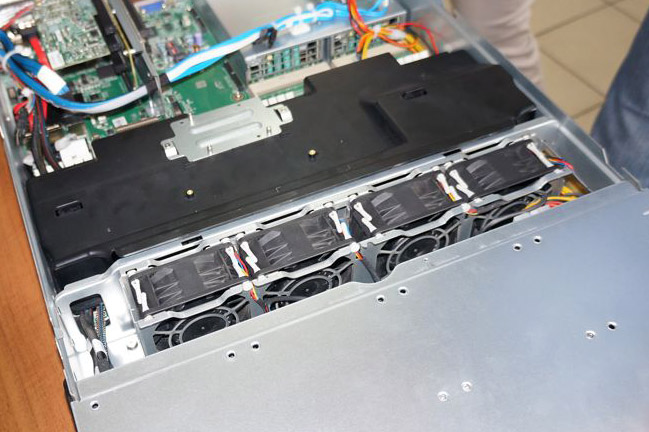 And finally, cooling. Here it is difficult to come up with something unique, you just need to carefully use the available space and carefully calculate and organize the air flow inside the case. The power supplies have their own individual fans. But for the rest of the cooling is responsible a group of four fans, located exactly between the basket of hard drives and the board. Fans are powerful and controlled by a service processor - this is the only way to achieve the necessary peak airflow from them and economical operation at medium loads.
And finally, cooling. Here it is difficult to come up with something unique, you just need to carefully use the available space and carefully calculate and organize the air flow inside the case. The power supplies have their own individual fans. But for the rest of the cooling is responsible a group of four fans, located exactly between the basket of hard drives and the board. Fans are powerful and controlled by a service processor - this is the only way to achieve the necessary peak airflow from them and economical operation at medium loads. 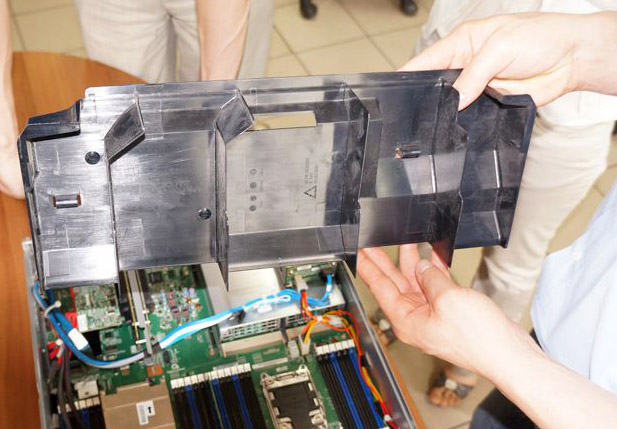 The air will pass first along the disks, then under the casing around the memory and passive radiators of the processors, and flowing around the expansion cards to go outside. Pay attention to the complex shape of the casing - thanks to it the air flow flows evenly through the entire internal space of the server.
The air will pass first along the disks, then under the casing around the memory and passive radiators of the processors, and flowing around the expansion cards to go outside. Pay attention to the complex shape of the casing - thanks to it the air flow flows evenly through the entire internal space of the server.  Oh, we almost forgot about management. In the second decade of the twenty-first century, it was somehow not customary to console-connect via a COM-port, or (here you can sob with nostalgia) drag the keyboard with the monitor, although the corresponding ports are available. No, you can, of course, but it is much more convenient to use such a thing as KVM over IP. Moreover, special service processors that provide full hardware control over the server using the web interface are no longer uncommon.
Oh, we almost forgot about management. In the second decade of the twenty-first century, it was somehow not customary to console-connect via a COM-port, or (here you can sob with nostalgia) drag the keyboard with the monitor, although the corresponding ports are available. No, you can, of course, but it is much more convenient to use such a thing as KVM over IP. Moreover, special service processors that provide full hardware control over the server using the web interface are no longer uncommon.  Well, something like this looks like inside the most modern rack server. In conclusion, I would like to ask you to tell us in the comments, what would you like to hear from us?
Well, something like this looks like inside the most modern rack server. In conclusion, I would like to ask you to tell us in the comments, what would you like to hear from us?
 Before we go inside the server, let us briefly introduce ourselves. We, the company ETegro Technologies, is a Russian company that develops and manufactures a wide variety of computing equipment, including servers, data storage systems, cluster solutions, workstations and graphics stations, and more ... For more information, visit our website: http: // www. etegro.com. We hope that our blog will become not just another “dull corporate blog of the company”, but a full-fledged interesting source of information. Well, now to the business. Perhaps, everyone who is interested in the server market has already managed to look at the new Intel platform. However, ETegro produces proprietary platforms. Therefore, we strive to share with you our original approach to the design of new generation servers. It is already our fourth, which is labeled as G4 at the end of the name.
Before we go inside the server, let us briefly introduce ourselves. We, the company ETegro Technologies, is a Russian company that develops and manufactures a wide variety of computing equipment, including servers, data storage systems, cluster solutions, workstations and graphics stations, and more ... For more information, visit our website: http: // www. etegro.com. We hope that our blog will become not just another “dull corporate blog of the company”, but a full-fledged interesting source of information. Well, now to the business. Perhaps, everyone who is interested in the server market has already managed to look at the new Intel platform. However, ETegro produces proprietary platforms. Therefore, we strive to share with you our original approach to the design of new generation servers. It is already our fourth, which is labeled as G4 at the end of the name. 
Let's take a look inside this 2U-handsome (we have single-unit models in this series, but they are almost the same in design, and we'll talk about them in one of the following posts, when ... well, we still have topics to talk about).
 The focus is on the motherboard of its own design, with two processor sockets located on it. The Intel Xeon E5-2600 series processors installed in them provide significant performance gains compared with the previous generation, reaching up to 80%, and in the case of floating point calculations, it is two-fold. This is largely due to the increased desire of the traditionally very conservative corporate sector to switch to a new platform - it saves space with a noticeable gain in performance.
The focus is on the motherboard of its own design, with two processor sockets located on it. The Intel Xeon E5-2600 series processors installed in them provide significant performance gains compared with the previous generation, reaching up to 80%, and in the case of floating point calculations, it is two-fold. This is largely due to the increased desire of the traditionally very conservative corporate sector to switch to a new platform - it saves space with a noticeable gain in performance.  The new design of the motherboard and the capabilities of the Intel Xeon E5-2600 processors allowed us to separate and install 24 DDR3-1600 memory slots on it. Memory does not happen much, right? So if finances allow, you can install up to 768 GB of memory in 4-channel mode in just one 2U server. A separate pleasant moment is the use of LRDIMM modules - their energy consumption is very small, which is extremely pleasant for both electricity bills and cooling needs.
The new design of the motherboard and the capabilities of the Intel Xeon E5-2600 processors allowed us to separate and install 24 DDR3-1600 memory slots on it. Memory does not happen much, right? So if finances allow, you can install up to 768 GB of memory in 4-channel mode in just one 2U server. A separate pleasant moment is the use of LRDIMM modules - their energy consumption is very small, which is extremely pleasant for both electricity bills and cooling needs.  Next come ... right, expansion slots. And here we again have something to interest the user. The fact is, we use daughter boards of our own production (there are already two slots for them), which allowed us to make them as compact as possible, and to rationalize the remaining space. As a result, with the help (no, not a hammer and some kind of mother there) of the riser (this is a special board that stands upright and allows you to put expansion cards parallel to the motherboard), we have five PCI-Express 3.0 slots. By the way, the metal platform on the plastic duct right in front of us is not our abstract whim, but a place to accommodate the battery of the RAID controller.
Next come ... right, expansion slots. And here we again have something to interest the user. The fact is, we use daughter boards of our own production (there are already two slots for them), which allowed us to make them as compact as possible, and to rationalize the remaining space. As a result, with the help (no, not a hammer and some kind of mother there) of the riser (this is a special board that stands upright and allows you to put expansion cards parallel to the motherboard), we have five PCI-Express 3.0 slots. By the way, the metal platform on the plastic duct right in front of us is not our abstract whim, but a place to accommodate the battery of the RAID controller. 
 As for the daughter boards, the one with the red textolite is the SAS RAID controller or HSI adapter of the LSI company (by the way, it is almost two times smaller than the analogous "proprietary" controller), and the second (green) bears on itself two 10G SFP + Ethernet port (there are two more ports on the motherboard itself, and they can be both Gigabit and 10G, if your network is already ready for such speeds). However, if you don’t need these daughterboards, but desperately want one more kind of your own controller, then you can put another riser into two slots instead of them, and you can install the additional sixth controller in it.
As for the daughter boards, the one with the red textolite is the SAS RAID controller or HSI adapter of the LSI company (by the way, it is almost two times smaller than the analogous "proprietary" controller), and the second (green) bears on itself two 10G SFP + Ethernet port (there are two more ports on the motherboard itself, and they can be both Gigabit and 10G, if your network is already ready for such speeds). However, if you don’t need these daughterboards, but desperately want one more kind of your own controller, then you can put another riser into two slots instead of them, and you can install the additional sixth controller in it.  Since we touched the word RAID - it's time to talk about the disk subsystem. Here, modern 2U systems have already formed a certain standard. We release 2 versions of the case: one is designed for 12 seats with hot-swapping for 3.5-inch disks - that’s what the title photo gives to the article. The second modification presented in the photo takes up to 24 2.5-inch drives due to the vertical installation of disks. In the first version, we decided to leave the user with maximum freedom, so we use special 3.5-inch landing baskets, which allow replacing “large »Drives on smaller brethren, which makes it easy to assemble mixed combinations (with modern SSD distribution, this is very practical) - what this option looks like can be seen in the photo below.
Since we touched the word RAID - it's time to talk about the disk subsystem. Here, modern 2U systems have already formed a certain standard. We release 2 versions of the case: one is designed for 12 seats with hot-swapping for 3.5-inch disks - that’s what the title photo gives to the article. The second modification presented in the photo takes up to 24 2.5-inch drives due to the vertical installation of disks. In the first version, we decided to leave the user with maximum freedom, so we use special 3.5-inch landing baskets, which allow replacing “large »Drives on smaller brethren, which makes it easy to assemble mixed combinations (with modern SSD distribution, this is very practical) - what this option looks like can be seen in the photo below.  And yet we wanted to stand out from the background of traditional server "designers", so the SAS-expander used by us can work along two access paths at once (of course, support from the controller is required), which means the disk basket has twice the SAS 6G throughput. What to do if “stuffing” the system with SSD'shkami, then this is not so much.
And yet we wanted to stand out from the background of traditional server "designers", so the SAS-expander used by us can work along two access paths at once (of course, support from the controller is required), which means the disk basket has twice the SAS 6G throughput. What to do if “stuffing” the system with SSD'shkami, then this is not so much.  We also provided for two additional seats for 2.5-inch disks near the power supplies - yes, there are two small compartments in the upper left. If you want to use the system to the maximum, then it is possible that they will come in very handy: after all, you can put a disk with the OS there, and fill the basket with one large array. Well, or send there a caching SSD for a RAID controller, if you want to use a similar option.
We also provided for two additional seats for 2.5-inch disks near the power supplies - yes, there are two small compartments in the upper left. If you want to use the system to the maximum, then it is possible that they will come in very handy: after all, you can put a disk with the OS there, and fill the basket with one large array. Well, or send there a caching SSD for a RAID controller, if you want to use a similar option. 
 Well, we smoothly got to power. And it is required decently, because it is necessary to proceed from the fact that the maximum configuration of possible components will be established. 2 processors, 24 memory modules, 14 disks, 7 expansion cards ... In general, hello 1100 watts. More precisely, two times 1100 W each, since a modern mid-level server is unthinkable without power redundancy. To accommodate them, we had to go to the trick, not only military, but engineering: at the output of power supplies, we remove only 12V for a couple of dozen conductors that go directly to the motherboard. All other voltages are created on the board itself. This approach not only eliminates the extra wires, but also allows you to significantly reduce the power supply in size. Honestly, it's hard to believe that this small box gives out a kilowatt, especially if traditional blocks of the same power intended for gaming computers have already fallen into the hands.
Well, we smoothly got to power. And it is required decently, because it is necessary to proceed from the fact that the maximum configuration of possible components will be established. 2 processors, 24 memory modules, 14 disks, 7 expansion cards ... In general, hello 1100 watts. More precisely, two times 1100 W each, since a modern mid-level server is unthinkable without power redundancy. To accommodate them, we had to go to the trick, not only military, but engineering: at the output of power supplies, we remove only 12V for a couple of dozen conductors that go directly to the motherboard. All other voltages are created on the board itself. This approach not only eliminates the extra wires, but also allows you to significantly reduce the power supply in size. Honestly, it's hard to believe that this small box gives out a kilowatt, especially if traditional blocks of the same power intended for gaming computers have already fallen into the hands.  And finally, cooling. Here it is difficult to come up with something unique, you just need to carefully use the available space and carefully calculate and organize the air flow inside the case. The power supplies have their own individual fans. But for the rest of the cooling is responsible a group of four fans, located exactly between the basket of hard drives and the board. Fans are powerful and controlled by a service processor - this is the only way to achieve the necessary peak airflow from them and economical operation at medium loads.
And finally, cooling. Here it is difficult to come up with something unique, you just need to carefully use the available space and carefully calculate and organize the air flow inside the case. The power supplies have their own individual fans. But for the rest of the cooling is responsible a group of four fans, located exactly between the basket of hard drives and the board. Fans are powerful and controlled by a service processor - this is the only way to achieve the necessary peak airflow from them and economical operation at medium loads.  The air will pass first along the disks, then under the casing around the memory and passive radiators of the processors, and flowing around the expansion cards to go outside. Pay attention to the complex shape of the casing - thanks to it the air flow flows evenly through the entire internal space of the server.
The air will pass first along the disks, then under the casing around the memory and passive radiators of the processors, and flowing around the expansion cards to go outside. Pay attention to the complex shape of the casing - thanks to it the air flow flows evenly through the entire internal space of the server.  Oh, we almost forgot about management. In the second decade of the twenty-first century, it was somehow not customary to console-connect via a COM-port, or (here you can sob with nostalgia) drag the keyboard with the monitor, although the corresponding ports are available. No, you can, of course, but it is much more convenient to use such a thing as KVM over IP. Moreover, special service processors that provide full hardware control over the server using the web interface are no longer uncommon.
Oh, we almost forgot about management. In the second decade of the twenty-first century, it was somehow not customary to console-connect via a COM-port, or (here you can sob with nostalgia) drag the keyboard with the monitor, although the corresponding ports are available. No, you can, of course, but it is much more convenient to use such a thing as KVM over IP. Moreover, special service processors that provide full hardware control over the server using the web interface are no longer uncommon.  Well, something like this looks like inside the most modern rack server. In conclusion, I would like to ask you to tell us in the comments, what would you like to hear from us?
Well, something like this looks like inside the most modern rack server. In conclusion, I would like to ask you to tell us in the comments, what would you like to hear from us?')
Source: https://habr.com/ru/post/146481/
All Articles